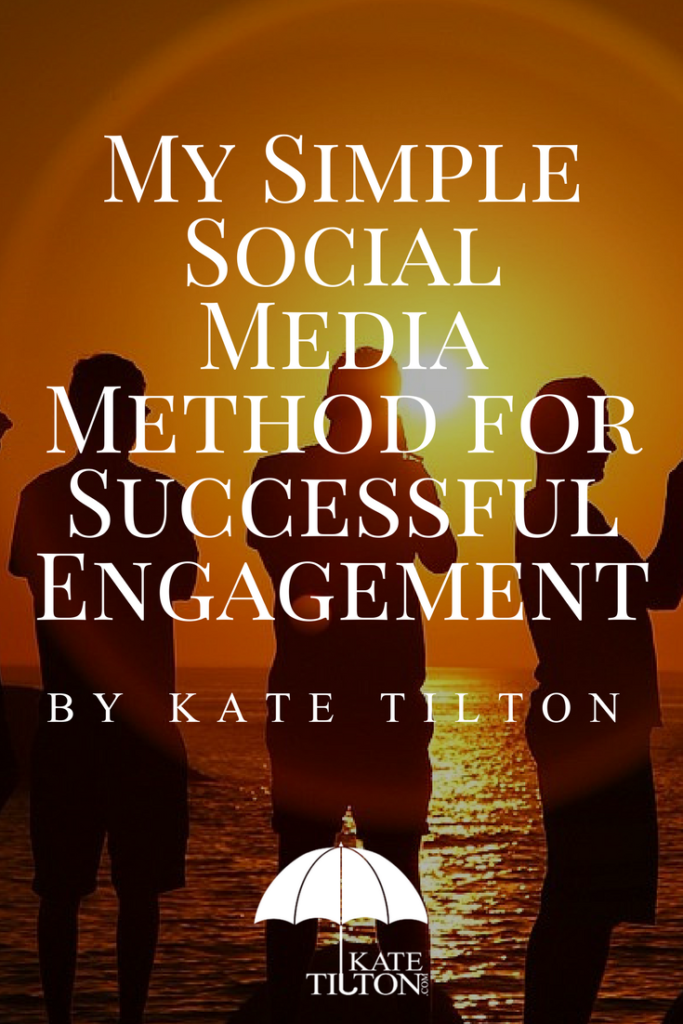
Social Media for Authors:
Spend less time doing more impactful engagement
Most authors’ social media process looks like this:
- Create accounts on all social media platforms they’ve ever heard of.
- Become overwhelmed by the advice and techniques on how to manage social media.
- Give up managing all channels perfectly and post when they get around to it, if at all.
Not all authors fall into that category, but it’s what I run into often when helping authors learn social media.
Ideally, your social media process should look like this:
- Determine your target market (the intended group for which something is marketed).
- Research where your target market is active online (Twitter, blogs, Facebook, etc.).
- Pick one or two of these channels to start with.
- Grow your channel(s), and gradually reduce the time required to manage each channel.
- Expand into a new social media channel one at a time (following your initial research on your target market).
- Repeat the learning and growing process for each new channel.
So how can you go from social media mess to social media mastery? Follow this plan to master your social media.
Know your audience
I bet you’ve heard this before, but it bears repeating because it’s the most vital part of any marketing you will ever do, period: having a clear picture of who you’re trying to reach will make everything you do in marketing easier and more effective.
As an author, you want to create a narrow target market. It’s even better if you can narrow down your target to a single reader, your number one fan who reads everything you write, comments on all your social media posts, and tells everyone about your books.
It’s much easier to get your number one fan to buy your book than it is to get a massive group of people you know nothing about to do so.
Many authors I’ve encountered struggle with this stage. They tell me, “But my book is for everyone!” Or they give me a target market that looks like this: 18-80-year-old women, romance readers.
Well, I can tell you right now what interests an 18-year-old romance reader and an 80-year-old romance reader are vastly different.
Here is where the problem lies, if you do not have a clear picture of a narrow target market: your marketing messages will be too generic and won’t appeal to anyone. It’s better to narrowly define who is most likely to enjoy your book and aim to create superfans than it is to try to please everyone.
If you write in different genres, you will want to create different narrow target markets for each genre. See where they overlap, then focus on the overlap for best results.
Before you even begin a social media account, get your target market down on paper. Start with these areas and narrow them down as you research: age, gender, location, education, profession, income, group affiliations, hobbies, lifestyles.
For example, instead of picking “male of any age,” you can narrow that to “male millennials.” Instead of “English-speaking countries,” you could say “Southeast USA.”
Don’t be afraid to go a step deeper or to make a mistake. The wonderful thing about social media is its constant evolution. The more involved you are in learning about your readers, the easier it will be to engage them in meaningful ways.
Your target market will guide your marketing efforts to ensure you reach those who are most likely to want to read your books. Being focused when it comes to your target market will allow you to craft a clear message that resonates with readers and leads to life-long fans of your books.
Once you have developed your target market, research where these readers live on social media. An easy way to do this is to check the social media accounts of authors who are writing books your target market adores. From those accounts, you can see where readers are most active.
Check Goodreads for groups focusing on your genre or look up some Twitter chats that allow you to connect directly with readers to learn more about their favorite places to hang out online.
Create a schedule that works for you
Once you’ve determined who your target market is and which accounts you’ll be starting with, it’s time to sit down and decide exactly how much time you have to commit to social media.
If social media is a part of your marketing strategy, you’ll have to commit regular intervals of time to devote to your social media efforts. I suggest authors aim for one hour a day from Monday to Friday when first starting out, and once established, aim to reduce that time by half.
By scheduling time, you make a commitment to be consistent on social media, which builds the trust readers have for you. The Internet has the memory of a goldfish, so by being consistent, you remain in the memory of those online.
No one checks Facebook pages that haven’t posted in weeks or Twitter accounts that post once in a blue moon. Develop a schedule that you will stick to of posts per channel per day.
My main posting schedule looks like this:
Twitter: 3 times per day
Facebook: 1 times per day
Instagram: 1 time per day
Pinterest: 1 or more times per day
And in the past it has looked like this:
Twitter: 12 times per day, Monday-Friday; 5 times per day Saturday-Sunday
Facebook: 2 times per day
Instagram: 1 time per day
Pinterest: 1 or more times per day
Depending on your audience, your schedule may differ. Take the time to research the channel you’re starting with to see how many posts per day is expected and aim to match that in your own efforts. And be aware that over time your schedule may change!
Post valuable content your readers want
Once you know the target audience you want to reach inside and out, it should be pretty clear what your audience is after. You should be able to answer these questions easily: What is the biggest pain/issue/problem they face? How can you help? Do they seek knowledge on a subject you know well? Are they looking for an escape after a hard day of classes/work/life? What matters to them?
Pick five areas of interest to your target market and post valuable content from those five areas. For example, my five areas are publishing, reading, and books; cats; social media and marketing; facts and productivity (think Mental Floss, life hacks); and geeky things like Doctor Who, Star Trek, and superheroes.
When looking for valuable content to post, remember variety is best. Try posting a combination of things in addition to cool links. Here are some types of posts you can use:
1. Pictures: Share a picture of your current read and ask your audience, “What are you reading?” Share a picture of your writing workspace. Share a picture of the stunning sunset or snow outside your window.
Someone told me it was #worldbookday …. ❤📖📚📓 #shelfie #shelf #bookshelf #bookshelves #sh… https://t.co/3uxNiriaxt pic.twitter.com/QrbGiZ5QCm
— Kate Tilton (@K8Tilton) March 4, 2016
2. Questions: Ask your readers to help you name characters when you’re stuck. Ask for casting suggestions for your latest book. Ask simple yes/no questions such as: “Do you like the snow?” Ask your readers what their favorite hobby, movie, book, or TV show is.
3. Quotes: Share a quote that resonates with you and your brand. Share a quote from your latest book (this is promotional, so use your own quotes sparingly). Share a quote from your current read. Share a quote from your favorite author.
“Quality is not an act, it is a habit.” – Aristotle
— Kate Tilton (@K8Tilton) April 3, 2017
4. Facts: Share facts about books, publishing, and facts you found while researching for your latest book.
5. Tips: Share tips to inspire writers and readers. Share tips related to the nonfiction subject you write about.
6. What’s going on in your life: Share updates about your everyday life. These little statements show readers that you are a person, just like them.
Him: how was your day? Me: dinner is mashed potatoes and bacon — Maggie Stiefvater (@mstiefvater) March 8, 2016
And remember unless you’re writing nonfiction for fellow writers, you’re trying to connect with readers who are more than likely not interested in writing their own books or publishing.
Focus, instead, on topics readers are looking for. The above ideas should help you get started with a reader-focused mind.
Adjust and grow
Becoming a part of a community takes time and effort but the results are well worth it. As you continue to work on your social media efforts, adjust as needed to the changes of each platform and your own schedule and needs.
Watch what works—what generates the greatest engagement? What are your readers commenting passionately about? Focus on learning new methods to apply to your social media efforts so you are constantly growing your audience of readers.
Don’t be afraid to get involved in conversations. Don’t wait for readers to come to you. Go to them.
Follow readers interested in your genre. Look at the content they’re sharing and contribute to the conversation when you have something of value to add. If a reader shares a review of a book you’ve read, take the time to read their review and comment with what you enjoyed about the book.
And most important of all, be yourself. Too often we are afraid to open up online and show our personality, but without that personality, we come across as boring, robot-like social media accounts.
And no one likes a robot.
So don’t be afraid to let your personality shine through. If you’re funny, be funny. If you’re geeky, let that geek flag fly high. By letting others see your personality, you’ll build stronger bonds with those who share your interests, and that’s priceless.


Leave a Reply